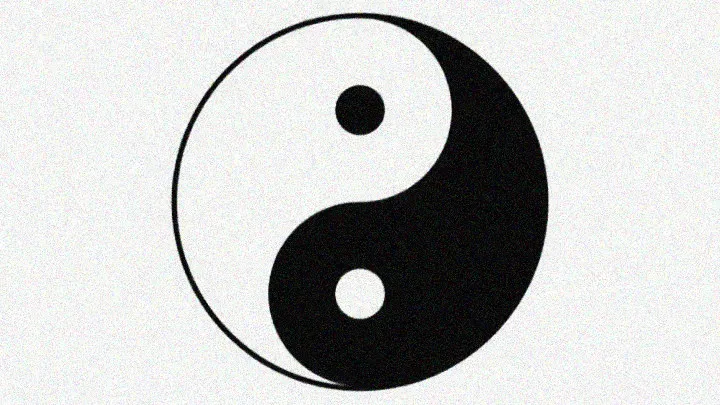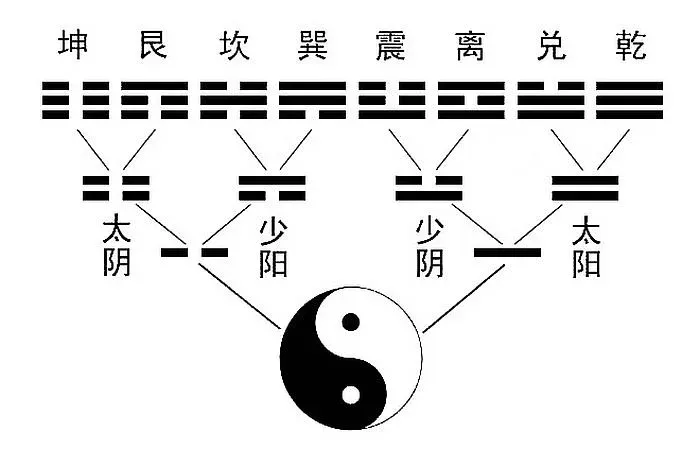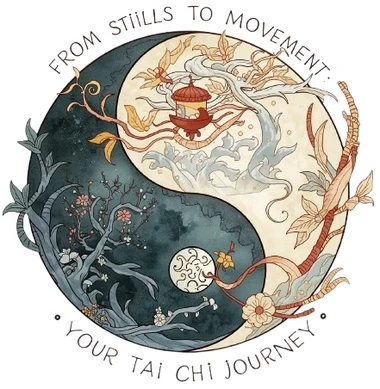What is Tai Chi (太极), Really?
You might be thinking of the slow, flowing exercises in the park. That’s Tai Chi Quan, a martial art built upon this philosophy. The original Tai Chi is a much bigger idea.
It’s the one before the one. The singular, undivided whole before the universe kicked into gear. Imagine a blank canvas before the first brushstroke, or a silent space before the first note of a song. That’s Tai Chi—the state of pure, unified potential.
Why it matters: This concept tells us that at the core of all complexity is a fundamental unity. The chaos and opposites we see in the world? They all came from the same place and are deeply connected.

What Exactly Are the Two Polarities (Liang Yi)?
So, how do we get something from this unified potential? The first step is division. Tai Chi differentiates into Liang Yi, the Two Polarities, best known as Yin and Yang.
Forget "good and evil." Yin and Yang are complementary forces, not warring enemies. You can't have one without the other.
Think of your own breath:
- Inhale (Yang): Active, expanding, taking in.
- Exhale (Yin): Passive, contracting, releasing.
You need both to live. This is the fundamental dance of the cosmos.
Their Symbolic Code:
The ancient sages represented these two forces with simple, genius lines:
- ⚊ A solid line = Yang. Representing activity, light, heaven, force.
- ⚋ A broken line = Yin. Representing receptivity, dark, earth, form.
This binary code is the foundation for everything that follows. It's the universe's first language.

How Do Two Polarities Become Four Symbols (Si Xiang)?
If Yin and Yang just sat there, nothing would ever happen. But they interact, combine, and shift. This dynamic interplay gives us the Four Symbols (Si Xiang).
By adding a second Yin or Yang line to the first, we get four possible combinations. These aren't just symbols; they're four fundamental phases of change.
| Symbol | Name | Chinese | Yin-Yang Combo | It's Like... |
|---|---|---|---|---|
| ⚌ | Great Yang | Tai Yang | Yang + Yang | High Noon: The peak of light & activity. |
| ⚍ | Lesser Yin | Shao Yin | Yang + Yin | Sunset: Yang is waning, Yin is growing. |
| ⚎ | Lesser Yang | Shao Yang | Yin + Yang | Sunrise: Yin is waning, Yang is growing. |
| ⚏ | Great Yin | Tai Yin | Yin + Yin | Midnight: The peak of darkness & rest. |
This is the secret to predicting patterns.
The Four Symbols map perfectly onto the world around us:
The Four Seasons:
- Shao Yang (⚎) = Spring. New growth, rising energy.
- Tai Yang (⚌) = Summer. Peak heat, full expansion.
- Shao Yin (⚍) = Autumn. Contraction, energy drawing in.
- Tai Yin (⚏) = Winter. Stillness, deep storage.
The Four Directions & Mythical Beasts:
- Azure Dragon (East) = Shao Yang. The rising dawn.
- Vermilion Bird (South) = Tai Yang. The brilliant midday sun.
- White Tiger (West) = Shao Yin. The descending dusk.
- Black Tortoise (North) = Tai Yin. The hidden, mysterious north.
A Business Project Cycle:
- Shao Yang: The exciting startup phase.
- Tai Yang: Launch and peak market push.
- Shao Yin: Analysis, refinement, and streamlining.
- Tai Yin: Planning the next big thing in quiet mode.
See the pattern? It’s a universal map of rise, peak, decline, and rest. Nothing escapes this cycle.
This isn't just philosophy; it's a user manual for the rhythms of nature and life. Understanding which phase you're in allows you to work with the energy, not against it.

How Do the Four Symbols Create the Eight Trigrams (Bagua)?
So we have our four powerful phases. But the universe loves complexity. The next step is as logical as a LEGO block snapping into place: a third line is added.
Each of the Four Symbols (which are two lines) combines with either a Yin or Yang line on top, creating eight unique three-line figures. These are the Eight Trigrams, or Bagua—the fundamental symbols you see on the Korean flag, in Taoist temples, and in Feng Shui consultations.
This isn't random magic. It's a systematic expansion of energy. Each trigram has a name, a core meaning, and represents a force of nature.
The Bagua Breakdown: Your Cheat Sheet to the Universe's Building Blocks
To make this easy, here’s a visual guide to the eight core trigrams. Think of these as the "atomic elements" of your reality.
Here’s what each of these Trigrams represents in your life:
| Trigram | Name | Meaning | It's Like... |
|---|---|---|---|
| ☰ | Qian | Heaven, Creativity, Father | The driving force to start a new venture. Pure Yang. |
| ☷ | Kun | Earth, Receptivity, Mother | The nurturing patience to see things through. Pure Yin. |
| ☳ | Zhen | Thunder, Activation, Arousal | The shocking phone call that changes your day. |
| ☵ | Kan | Water, Danger, The Abyss | The "deep end" of a project where you feel in over your head. |
| ☶ | Gen | Mountain, Stillness, Stopping | The wisdom to pause and not force a solution. |
| ☴ | Sun | Wind, Penetration, Gentle Influence | The subtle idea that slowly changes your mind. |
| ☲ | Li | Fire, Radiance, Clarity | The "aha!" moment of brilliant understanding. |
| ☱ | Dui | Lake, Joy, Communication | The happy celebration with your team after a win. |
How to Remember Them (Seriously)
There's a classic Chinese rhyme that makes this easy. Say it out loud:
- Qian San Lian (乾三连) - Qian is three unbroken lines.
- Kun Liu Duan (坤六断)- Kun is six broken segments.
- Zhen Yang Yu (震仰盂) - Zhen is like a bowl facing up.
- Gen Fu Wan (艮覆碗) - Gen is like a bowl turned over.
- Li Zhong Xu (离中虚) - Li is empty in the middle.
- Kan Zhong Man (坎中满) - Kan is full in the middle.
- Dui Shang Que (兑上缺) - Dui is broken on top.
- Sun Xia Duan (巽下断) - Sun is broken on the bottom.
This symbolic language gives you a vocabulary for the invisible forces shaping your life. Feeling stuck? That's Gen (Mountain). Need a breakthrough? Call on Zhen (Thunder).

How Can You Use This Ancient System Today?
Want to See How This Works in Your Own Space?
Understanding the theory is one thing - but seeing how it applies to your actual home or office is where the real magic happens.
That's why we created the 太极八卦方位查询工具 - Interactive Feng Shui Direction Tool - your personal digital Feng Shui compass.
With our interactive tool, you can:
- Instantly calculate your personal auspicious directions
- See exactly how the Bagua maps onto your floor plan
- Get specific recommendations for enhancing each life area
- Understand which elements to emphasize in which zones
No complex calculations or prior knowledge needed. Just enter your basic information and let the tool do the work.
"I'd been reading about Bagua for years, but this tool made it click instantly. Seeing my apartment mapped out with the exact directions and elements was a game-changer." - Sarah L., longtime practitioner
Try Our Free Bagua Compass Tool Now
This is where it gets practical. You don't need to be a sage to apply this. You just need to see the patterns.
1. For Personal Growth & Decision Making
Is your life all Tai Yang (constant action, summer)? You'll burn out. Is it all Tai Yin (rest, winter)? You'll stagnate. The key is to flow between them.
Ask yourself:
- "What season am I in right now?"
- "Do I need to push (Yang) or receive (Yin)?"
- "Is this situation a Kan (Water) challenge requiring patience, or a Zhen (Thunder) moment demanding immediate action?"
2. For Understanding Business & Team Dynamics
A startup is pure Qian (Heaven) energy—visionary and driving. But without Kun (Earth)—the structure and support—it will collapse. Is your marketing Li (Fire)—brilliant and visible? Is your cash flow Kan (Water)—fluid and deep?
3. For Your Health (The Traditional Chinese Medicine Connection)
TCM is built on this. Health isn't just the absence of disease; it's the dynamic balance of Yin and Yin in your body.
- Yang (activity) issues might look like inflammation, hyperactivity, or stress.
- Yin (substance) issues might look like fatigue, dryness, or low energy.
Balancing them is the goal. This is why some exercises (like Tai Chi Quan) are designed to cultivate both simultaneously.
The goal isn't to be perfectly balanced in the middle, but to be fluidly responsive to change—knowing when to expand and when to contract, just like your breath.

How Do I Start Practicing This Wisdom Today?
You don't need to memorize all 64 hexagrams to make this philosophy work for you. The power is in applying the core principle: Observe the patterns of change and align with them.
Think of it as learning to sail. You don't command the wind or the sea—you learn to adjust your sails to navigate them masterfully. This is the art of living in flow.
Here’s your actionable checklist to start:
1. Identify Your Current "Season":
Pause for one minute and ask: "Is my energy like Spring (starting new things), Summer (at peak activity), Autumn (winding down and refining), or Winter (resting and planning)?" Honor that phase. Don't push a winter project with summer energy.
2. Conduct a Personal Yin-Yang Audit:
Where is your life out of balance?
- Too Much Yang? (Constant doing, stress, irritation) → Inject Yin: 10 minutes of quiet meditation, a slow walk, turning off notifications.
- Too Much Yin? (Lethargy, lack of direction, stagnation) → Inject Yang: *A brisk walk, a 30-minute focused work sprint, a clear, actionable goal.*
3. Use the Trigrams as a Problem-Solving Lens:
Stuck on a problem? Run through the Bagua:
- Need a new idea? → Qian (Heaven). Brainstorm wildly.
- Feeling overwhelmed? → Gen (Mountain). Stop. Do nothing. Let the solution come to you.
- Can't get your point across? → Sun (Wind). Influence gently instead of forcing.
- Team morale low? → Dui (Lake). Create a moment of joy and connection.
This system isn't about adding more tasks to your life. It's about changing your perspective on the tasks already there. It turns struggle into strategy.

The Ultimate Goal: From Knowledge to Embodiment
Reading about Tai Chi and the Yi Jing is one thing. Feeling it is another. The deepest understanding doesn't come from your head, but from your lived experience.
This is why practices like Tai Chi Quan and Qigong were developed. They are the physical embodiment of this philosophy. When you move through the forms, you are literally tracing the patterns of Yin and Yang, expansion and contraction, with your own body. You aren't just thinking about balance; you are practicing it, neuron by neuron, muscle by muscle.
Your journey doesn't end here. It starts here. Look at the world through this new lens. Watch how day turns to night. Notice the cycle of your own energy throughout the week. See the Four Symbols in every project you undertake.
This is a living system, and you are now a part of it.
Ready to Embody the Balance? This ancient map is just the beginning. At www.taichiwuji.com, we bring these principles to life through movement, breath, and modern practice. Explore our resources and start your journey from understanding to embodiment today.
Ready to Apply This Wisdom to Your Actual Space?
Reading about these concepts is the first step. But the real transformation happens when you apply them to your actual living environment.
Stop guessing and start knowing with our free interactive tool:
In just a few clicks, you'll have:
- Your personal Bagua direction map
- Specific enhancement tips for each area
- Clear guidance on colors and elements
- A customized blueprint for balanced energy
No registration required • 100% free • Instant results
FAQ
What does "Tai Chi generates Two Polarities, Two Polarities generate Four Symbols" mean?
This foundational concept from China's I Ching (Book of Changes) describes the cosmic evolution from unity to multiplicity. "Tai Chi" is the primordial unity. It differentiates into "Two Polarities" (Yin and Yang), whose interactions form the "Four Symbols" - four core phases of change that map to seasons, directions, and the fundamental forces of nature.
What are the Four Symbols in Taoist cosmology?
The Four Symbols (Si Xiang) are four distinct states generated by the interplay of Yin and Yang energy: Tai Yang (Great Yang): Peak activity & expansion (Summer, South) Shao Yin (Lesser Yin): Gentle decline & receptivity (Autumn, West) Tai Yin (Great Yin): Deep stillness & storage (Winter, North) Shao Yang (Lesser Yang): New growth & emergence (Spring, East)
How do the Four Symbols relate to Bagua (Eight Trigrams)?
The Four Symbols form the foundation for the Eight Trigrams (Bagua). Each Symbol (a two-line figure) combines with either a Yin or Yang line, creating eight possible three-line combinations. These trigrams represent fundamental natural phenomena like Heaven, Earth, Thunder, and Water, providing a symbolic language for understanding all aspects of reality.
What's the difference between Tai Chi and Yin Yang?
Tai Chi represents the unified, undivided state before creation - the source containing both potentials. Yin Yang describes the two complementary forces that emerge from Tai Chi, whose dynamic interaction drives all change and manifestation in the visible universe.
How can I apply Four Symbols wisdom to daily life?
Identify Your Energy Season: Are you in creative Spring (Shao Yang), productive Summer (Tai Yang), reflective Autumn (Shao Yin), or restorative Winter (Tai Yin)? Balance Activities: Counter intense Yang activity (workouts) with Yin restoration (meditation) Make Better Decisions: Use Four Symbols timing - launch projects in Spring energy, complete them in Summer
What are the Four Symbols animals in Chinese culture?
The Four Symbols are represented by four celestial animals: Azure Dragon of the East (Spring, Wood element) Vermilion Bird of the South (Summer, Fire element) White Tiger of the West (Autumn, Metal element) Black Tortoise of the North (Winter, Water element)
Where does "Tai Chi generates Two Polarities" appear in I Ching?
This cosmic principle appears in the Great Commentary (Xi Ci) of the I Ching, Chapter 11: "Therefore the Change has the Great Ultimate (Tai Chi), which generates the Two Polarities (Liang Yi), which generate the Four Symbols (Si Xiang), which generate the Eight Trigrams (Bagua)."
How do the Four Symbols influence Traditional Chinese Medicine?
In TCM, the Four Symbols correspond to seasonal energies that affect health: Spring (Shao Yang): Liver/Gallbladder health, new growth Summer (Tai Yang): Heart/Small Intestine, circulation peak Autumn (Shao Yin): Lungs/Large Intestine, letting go Winter (Tai Yin): Kidneys/Bladder, energy conservation
What's the connection between Four Symbols and Feng Shui?
The Four Symbols formation (Green Dragon left, White Tiger right, Red Bird front, Black Tortoise back) creates the ideal Feng Shui site arrangement. This celestial template ensures balanced energy flow and protection in any space, from homes to entire landscapes.
How do the Four Symbols represent cosmic cycles?
The Four Symbols model universal rhythms through: Daily Cycle: Sunrise (Shao Yang), Noon (Tai Yang), Sunset (Shao Yin), Midnight (Tai Yin) Life Cycle: Birth (Shao Yang), Prime (Tai Yang), Maturity (Shao Yin), Wisdom (Tai Yin) Business Cycle: Startup (Shao Yang), Growth (Tai Yang), Maturity (Shao Yin), Renewal (Tai Yin)
